The Future of EVM Technology: A Journey Beyond Ethereum's Boundaries
Since its launch in 2015, the EVM has evolved significantly, and it is expected to continue to advance as developers and businesses explore new use cases and applications for the technology.

The Ethereum Virtual Machine (EVM) is a crucial component of the Ethereum network, responsible for executing smart contracts and powering decentralized applications (dApps) on the blockchain. Since its launch in 2015, the EVM has evolved significantly, and it is expected to continue to advance as developers and businesses explore new use cases and applications for the technology.
EVM - A Quick Refresher
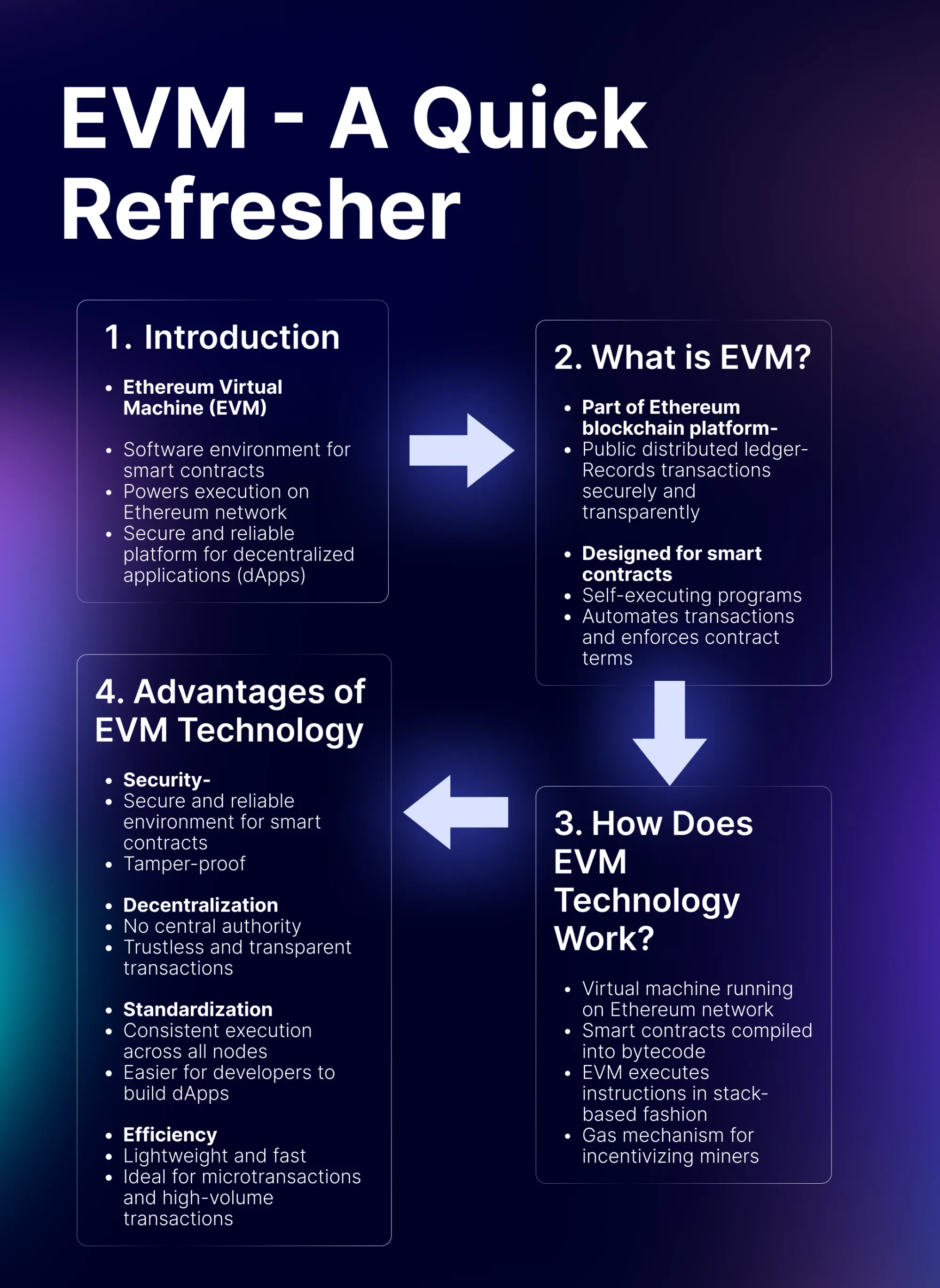
The Ethereum Virtual Machine (EVM) is a software environment that powers the execution of smart contracts on the Ethereum network. The EVM provides a secure and reliable platform for developers to build decentralized applications (dApps) and blockchain-based solutions that can automate transactions, enforce contracts, and execute logic in a trustless and transparent manner.
What is EVM?
The EVM is a part of the Ethereum blockchain platform, which is a public distributed ledger that records transactions between two parties in a decentralized and secure way. It was designed to enable the execution of smart contracts, which are self-executing programs that can automate the execution of transactions and enforce contract terms in a decentralized and trustless way.
The EVM provides an isolated and sandboxed environment for the execution of smart contracts, ensuring that they cannot interfere with the operation of the Ethereum network or other smart contracts. This isolation also ensures that smart contracts can execute in a deterministic and predictable way, ensuring that the outcome
of the contract is consistent across all nodes in the network.
How Does EVM Technology Work?
The EVM is a virtual machine that runs on top of the Ethereum network, providing a standardized environment for the execution of smart contracts. When a smart contract is deployed on the network, it is compiled into bytecode, which the EVM then executes.
The EVM has a set of instructions that can be used to execute the bytecode, such as arithmetic operations, conditional statements, and input/output operations. The EVM executes these instructions in a stack-based fashion, where each instruction takes inputs from the stack and outputs results to the stack.
The EVM also has a gas mechanism, which is used to incentivize miners to execute smart contracts. Gas is a unit of measurement that is used to calculate the cost of executing a smart contract, with more complex operations requiring more gas to execute.
Advantages of EVM Technology
The EVM offers several advantages to businesses and developers in the blockchain space, including:
- Security
The EVM provides a secure and reliable environment for the execution of smart contracts, ensuring that they cannot be tampered with or modified by malicious actors.
- Decentralization
The EVM operates on a decentralized network, meaning that there is no central authority controlling the execution of smart contracts. This ensures that transactions can be executed trustless and transparently, without the need for intermediaries.
- Standardization
The EVM provides a standardized environment for the execution of smart contracts, ensuring that they can be executed consistently across all nodes in the network. This makes it easier for developers to build dApps and blockchain-based solutions that can be deployed on the Ethereum network.
- Efficiency
The EVM is designed to be efficient and lightweight, ensuring that smart contracts can be executed quickly and at a low cost. This makes it an ideal platform for the execution of microtransactions and other high-volume transactions.
Exploring Ethereum & Other Leading Blockchain Platforms: Expanding the EVM Ecosystem
The blockchain space is constantly evolving, and developers are always looking for new and innovative ways to build decentralized applications (dApps) and blockchain-based solutions. One of the most popular platforms for building these solutions is the Ethereum blockchain platform, which utilizes the Ethereum Virtual Machine (EVM) to execute smart contracts. However, there are also other leading blockchain platforms that use EVM technology to power their solutions - Bitfinity EVM.
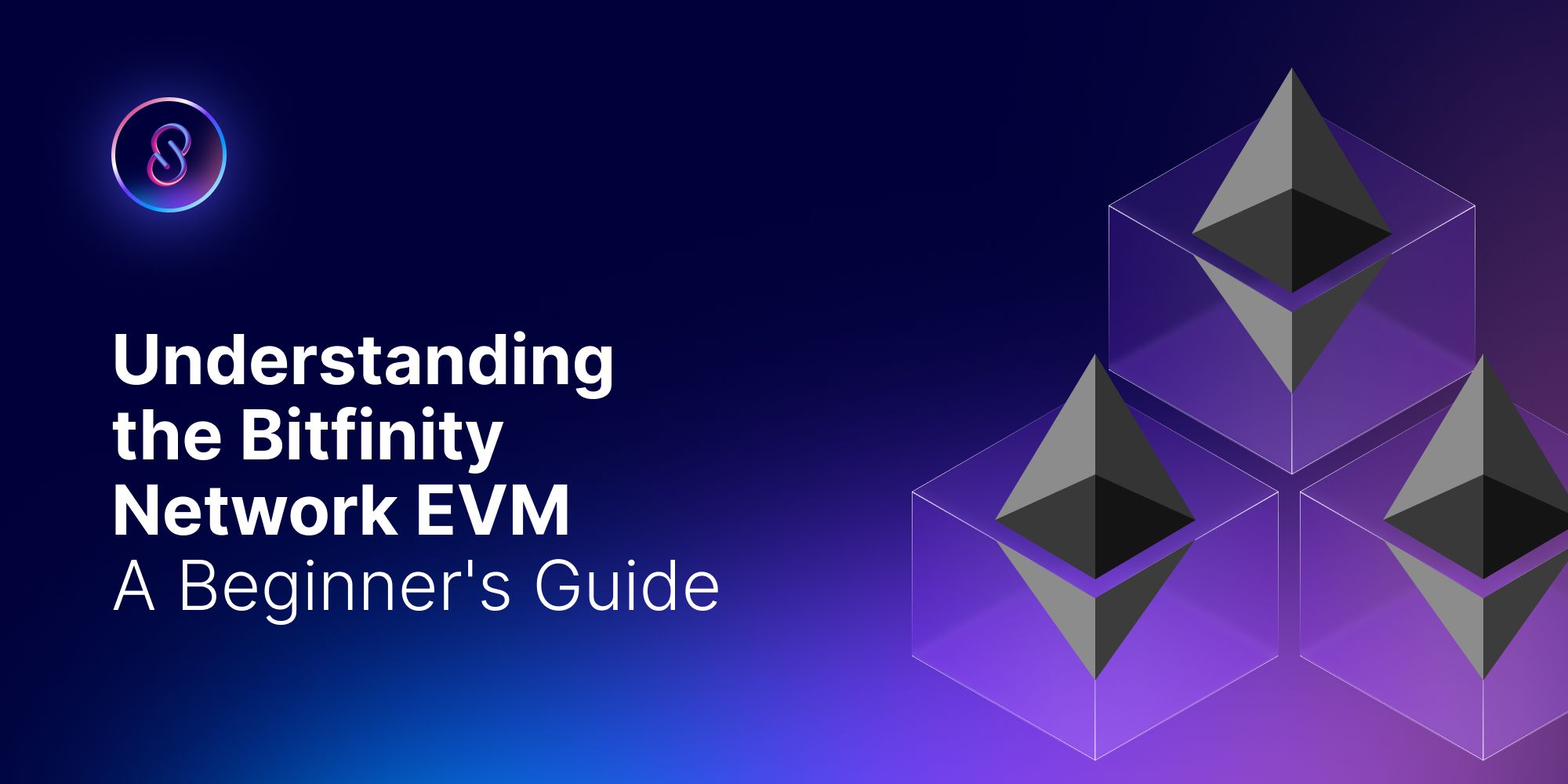
Others Include -
- Quorum: An Ethereum-based, permissioned blockchain platform designed for financial services and other industries requiring privacy and high transaction throughput.
- Binance Smart Chain (BSC): BSC is a blockchain network built for running smart contract-based applications, with compatibility for EVM-based tools and dApps.
- Avalanche: A scalable, high-performance blockchain platform that supports EVM smart contracts and enables seamless interaction between decentralized applications.
- Polygon: A layer-2 scaling solution for Ethereum that uses a Proof-of-Stake (PoS) consensus mechanism and supports EVM-compatible smart contracts.
These examples illustrate that EVM technology is not limited to Ethereum and can be adopted by other blockchain platforms to build innovative solutions.
Embracing Interoperability with EVM Technology
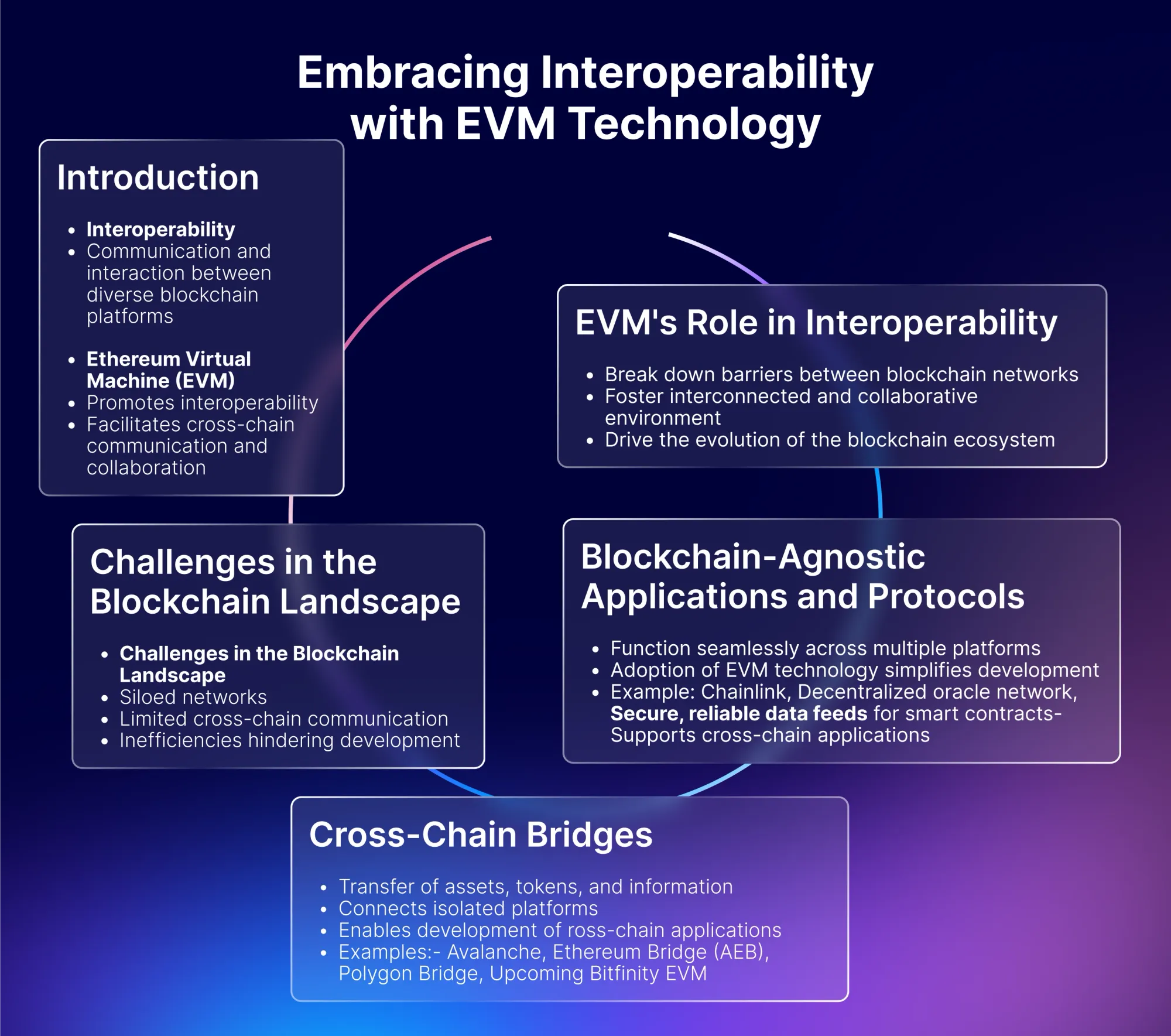
As the blockchain ecosystem continues to mature, the need for interoperability among different networks has become increasingly important. Interoperability refers to the ability of diverse blockchain platforms to communicate and interact seamlessly with each other, enabling the exchange of information, assets, and value across their respective networks. Ethereum Virtual Machine (EVM) technology plays a pivotal role in promoting interoperability as more blockchain platforms adopt EVM compatibility to facilitate cross-chain communication and collaboration.
EVM's role in interoperability comes into focus when we consider the challenges faced by the existing blockchain infrastructure. The current landscape is characterized by a multitude of independent, siloed networks with little to no interaction between them. This lack of cross-chain communication results in inefficiencies and hinders the development of a truly global, interconnected blockchain ecosystem.
To address these challenges, EVM-compatible blockchain platforms have started implementing cross-chain bridges, which serve as essential tools for fostering interoperability. These bridges allow for the transfer of assets, tokens, and information across different networks, thus connecting the previously isolated platforms and enabling the development of cross-chain applications.
Two notable examples of cross-chain bridges in the EVM ecosystem are:
- Avalanche-Ethereum Bridge (AEB): AEB is a decentralized bridge that enables the seamless transfer of Ethereum-based assets to the Avalanche blockchain and vice versa. By leveraging EVM compatibility, the AEB allows developers to easily deploy Ethereum smart contracts on the Avalanche network, taking advantage of its faster transaction times and lower fees.
- Polygon Bridge: This bridge connects the Ethereum mainnet with the Polygon network, a layer-2 scaling solution designed to improve Ethereum's performance and reduce transaction costs. The Polygon Bridge facilitates the movement of assets between the two networks while also enabling developers to utilize EVM-compatible smart contracts on the Polygon platform.
These cross-chain bridges are just the beginning, as more EVM-compatible networks are expected to emerge in the coming years, further emphasizing the importance of EVM technology in promoting interoperability. Especially the upcoming Bitfinity EVM.
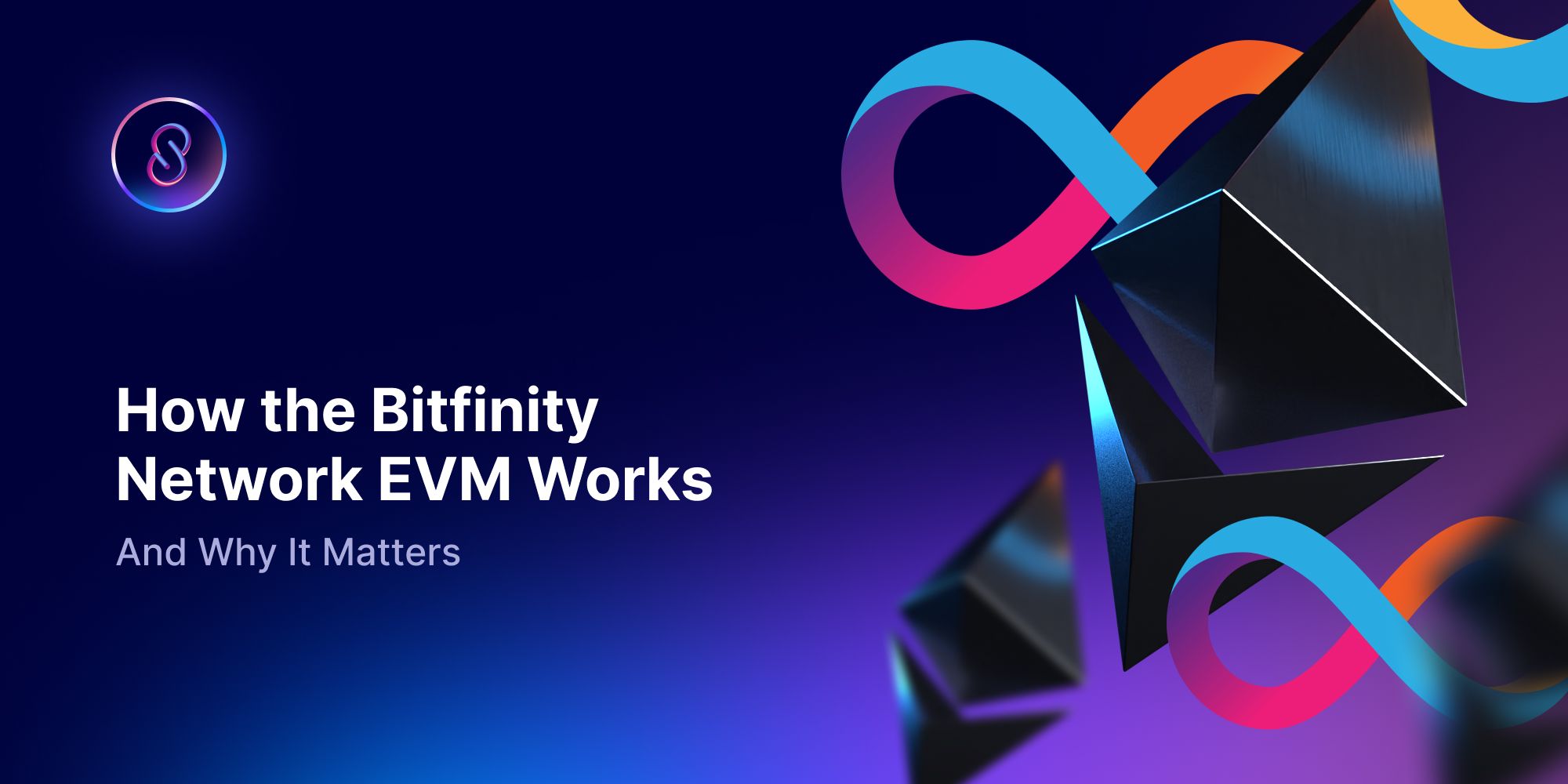
In addition to cross-chain bridges, EVM technology enables the development of blockchain-agnostic applications and protocols. These solutions are built to function seamlessly across multiple blockchain platforms, regardless of their underlying infrastructure. The adoption of EVM technology by various networks makes it easier for developers to create interoperable solutions, as they can leverage familiar tools and programming languages.
One such example is Chainlink, a decentralized oracle network that provides secure, reliable data feeds to smart contracts on various EVM-compatible blockchains. By utilizing EVM technology, Chainlink can serve as a vital component in the development of cross-chain applications, ensuring the integrity and accuracy of the data used by these applications.
As the blockchain ecosystem continues to evolve, interoperability will remain a crucial concern, and EVM technology will play an instrumental role in addressing this issue. By enabling seamless communication between different blockchain networks, EVM technology has the potential to break down the barriers that currently separate them, fostering a more interconnected and collaborative environment.
EVM and DeFi - A Thriving Partnership
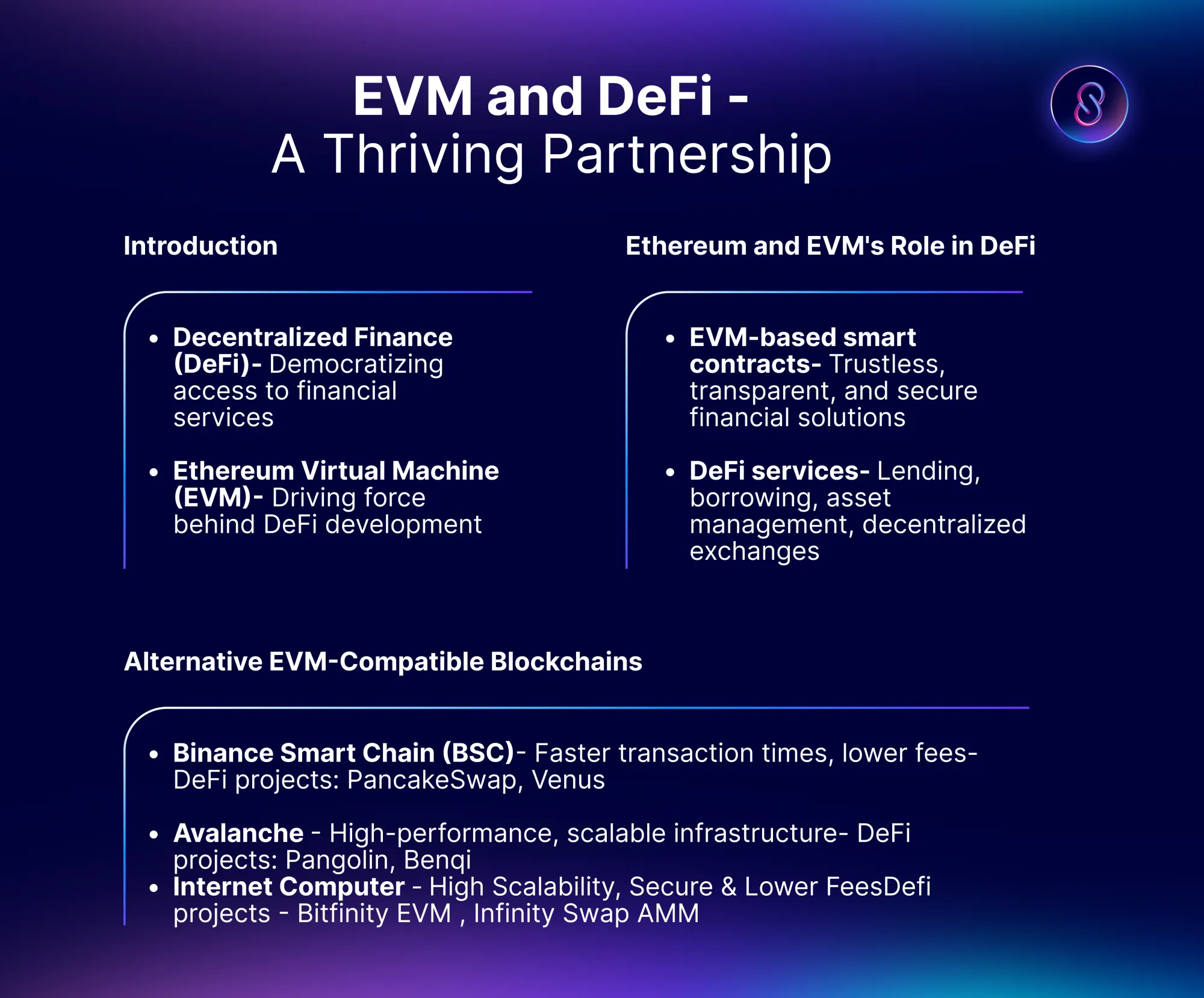
Decentralized Finance (DeFi) has emerged as a groundbreaking innovation in the world of finance, democratizing access to financial services and challenging traditional centralized systems. At the core of the DeFi revolution lies Ethereum Virtual Machine (EVM) technology, which has been the driving force behind the development and growth of various DeFi platforms and applications. As the DeFi ecosystem expands beyond Ethereum to other EVM-compatible blockchains, the partnership between EVM and DeFi continues to thrive, paving the way for new opportunities and innovations.
Ethereum's smart contract capabilities, powered by EVM technology, have been crucial in the development of the DeFi landscape. DeFi platforms leverage smart contracts to enable a wide array of financial services, such as lending, borrowing, asset management, and decentralized exchanges. The programmable nature of EVM-based smart contracts allows for the creation of trustless, transparent, and secure financial solutions that operate without the need for intermediaries.
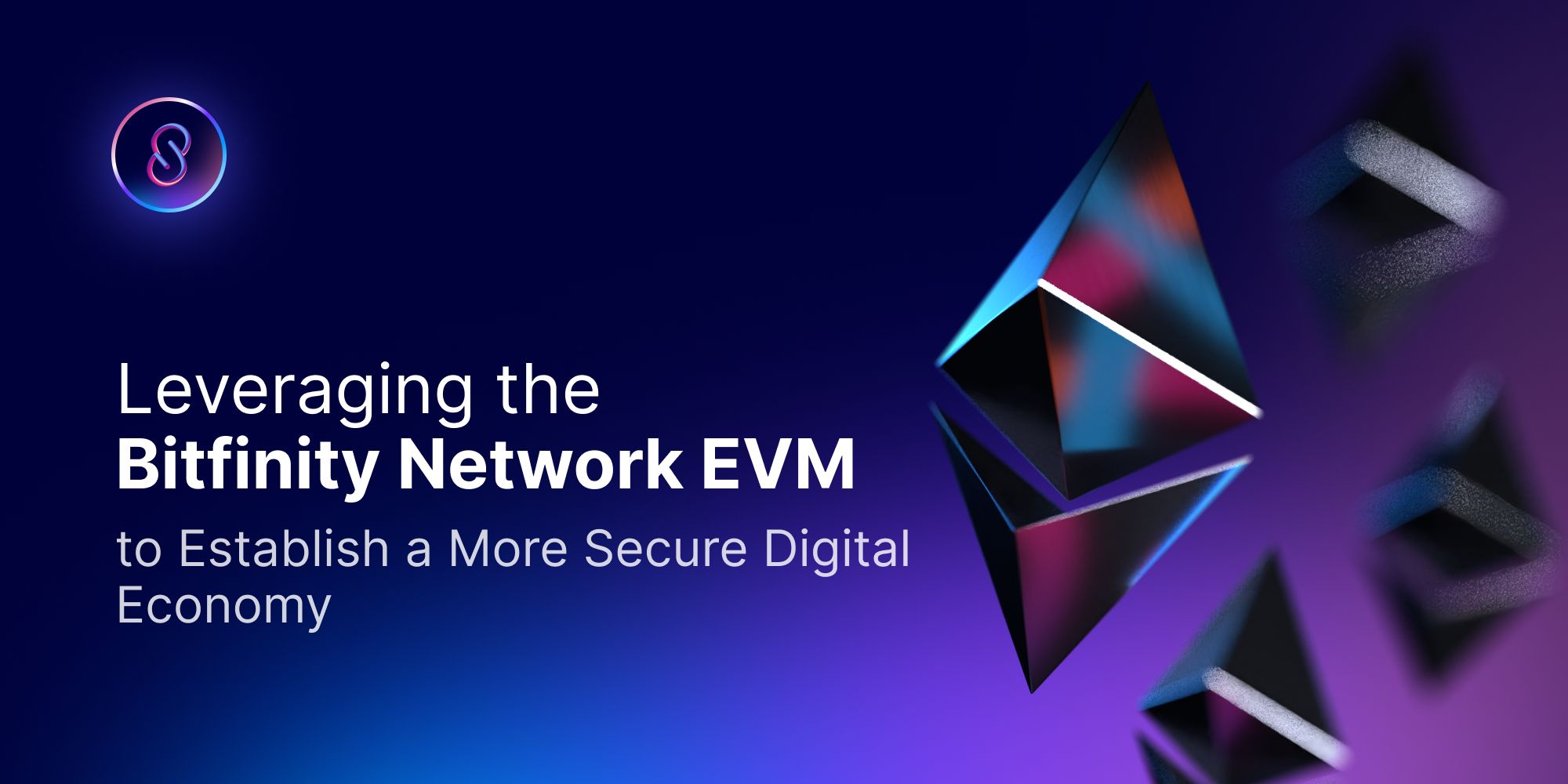
However, Ethereum's limitations in terms of scalability and high transaction fees have led to the exploration of alternative EVM-compatible platforms that can offer improved performance while maintaining compatibility with the existing DeFi ecosystem. Some notable EVM-compatible blockchains fostering the growth of DeFi include:
- Binance Smart Chain (BSC): BSC is an EVM-compatible blockchain platform that has gained significant traction in the DeFi space. It offers faster transaction times and lower fees compared to Ethereum, making it an attractive option for DeFi developers and users. Many popular DeFi projects, such as PancakeSwap and Venus, have found success on BSC, highlighting the growing trend of DeFi expansion beyond Ethereum.
- Avalanche: A high-performance blockchain platform that supports EVM smart contracts, Avalanche has been rapidly gaining popularity among DeFi developers. Its unique consensus mechanism and scalable infrastructure allow for fast and low-cost transactions, making it a suitable alternative for hosting DeFi applications. Projects like Pangolin, a decentralized exchange, and Benqi, a liquidity market protocol, have established themselves on Avalanche, demonstrating the platform's potential in the DeFi space.
The growth of DeFi on these alternative EVM-compatible blockchains highlights the adaptability and flexibility of EVM technology. By providing a familiar development environment and compatibility with existing Ethereum-based tools and dApps, EVM technology enables DeFi solutions to thrive on multiple platforms, expanding the reach and impact of the DeFi ecosystem.
Moreover, the compatibility of these blockchains with EVM technology also plays a significant role in promoting cross-chain DeFi solutions. As mentioned earlier, cross-chain bridges like the Avalanche-Ethereum Bridge facilitate the transfer of assets and interaction between DeFi platforms on different networks, enabling users to access a broader range of DeFi services and promoting liquidity across the ecosystem.
Conclusion
In conclusion, the Ethereum Virtual Machine (EVM) has proven to be an indispensable component in the world of blockchain and decentralized finance, powering innovative solutions and fostering the growth of the DeFi ecosystem. By enabling the development of smart contracts and dApps across a range of EVM-compatible platforms, EVM technology has expanded its reach beyond Ethereum, allowing for increased scalability, improved performance, and greater adoption of decentralized financial solutions.
Interoperability has emerged as a key theme in the blockchain space, and EVM technology has been instrumental in bridging the gap between different networks. Cross-chain bridges and blockchain-agnostic applications exemplify the potential of EVM technology in promoting seamless communication and collaboration among diverse platforms, ensuring a more interconnected and efficient blockchain ecosystem.
The thriving partnership between EVM and DeFi demonstrates the adaptability and versatility of EVM technology, and its ability to drive innovation in the financial sector. As DeFi platforms continue to evolve and expand beyond Ethereum, EVM technology remains at the core of this revolution, enabling the development of secure, transparent, and efficient financial solutions that challenge traditional centralized systems.
As the blockchain landscape continues to advance, the significance of EVM technology is expected to grow further, unlocking new possibilities and use cases for developers and businesses alike. The future of EVM technology looks promising, with its potential to shape the next generation of decentralized applications and transform the way we interact with finance and other industries. The upcoming Bitfinity EVM and other EVM-compatible platforms will undoubtedly play a crucial role in the continued growth and evolution of the blockchain ecosystem, paving the way for a more decentralized and interconnected world.

Connect with Bitfinity Network
Bitfinity Wallet |Bitfinity Network | Twitter | Website | Telegram | Discord | Github






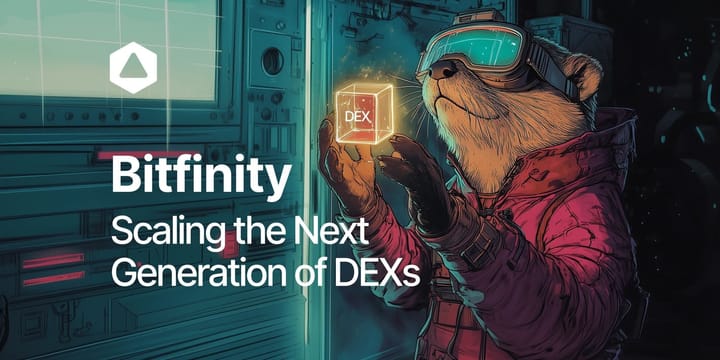
Comments ()